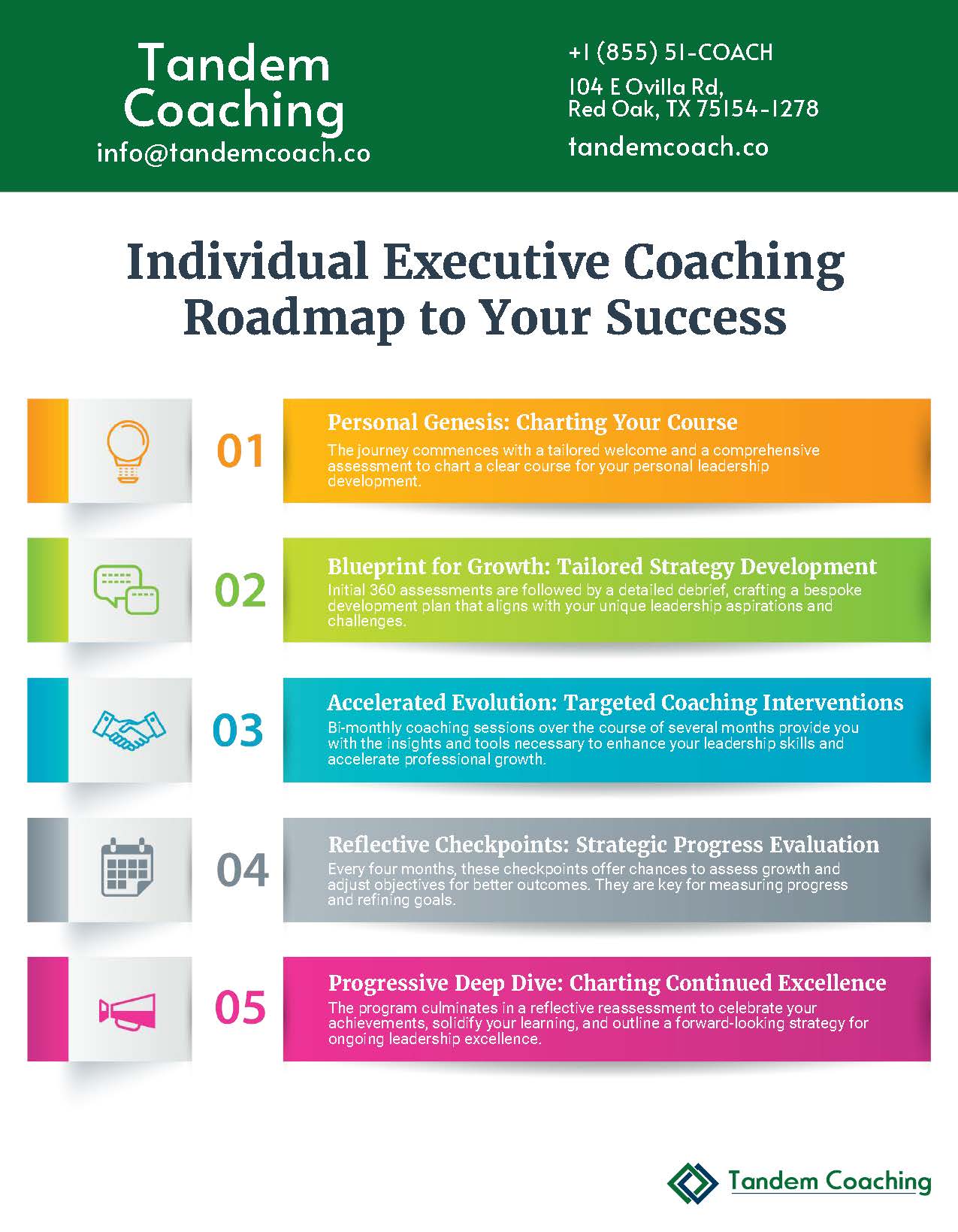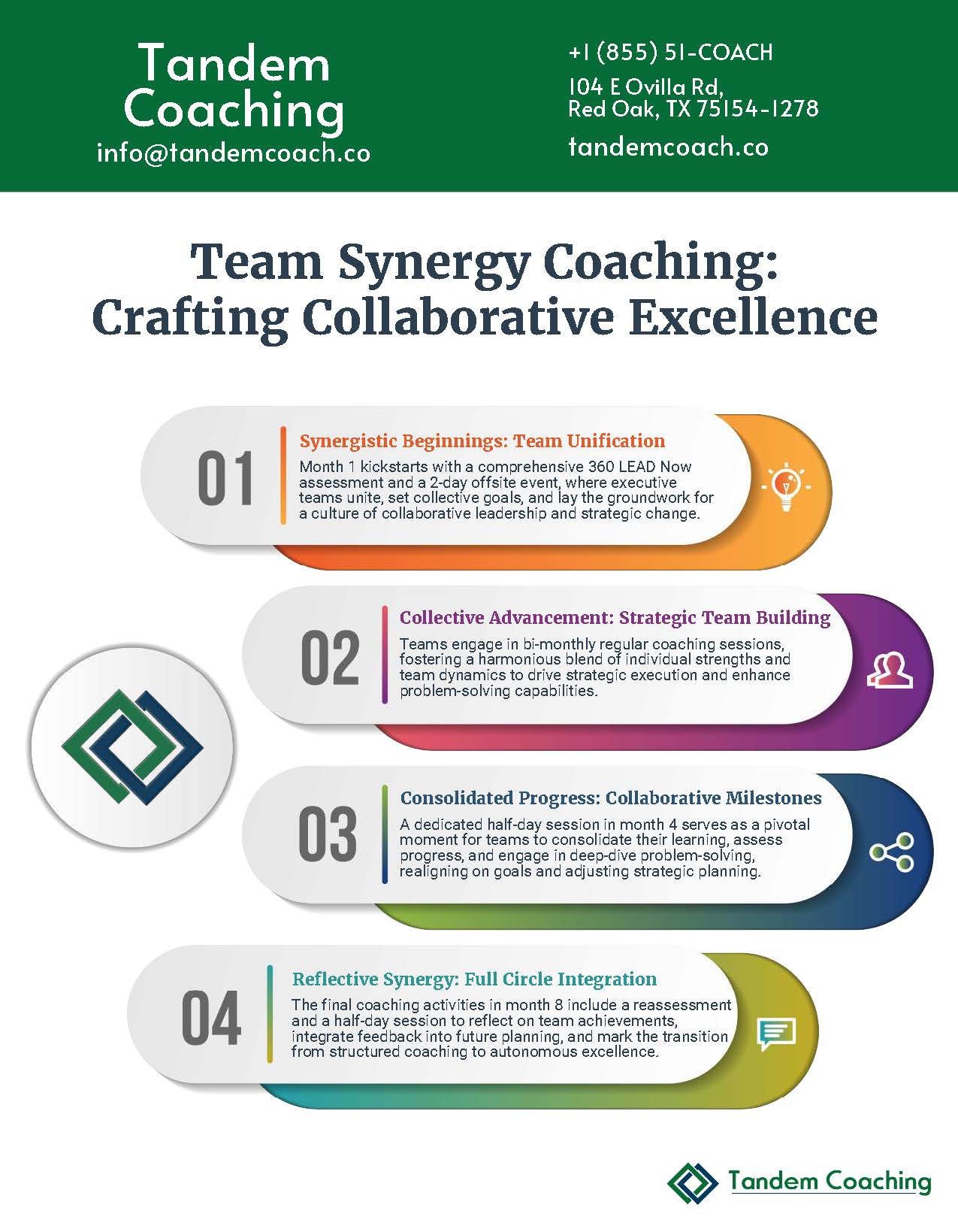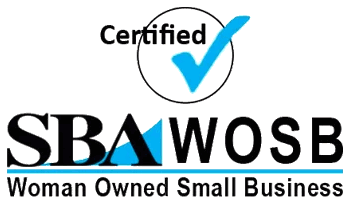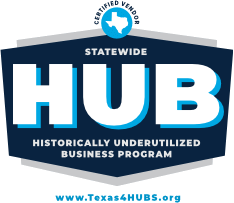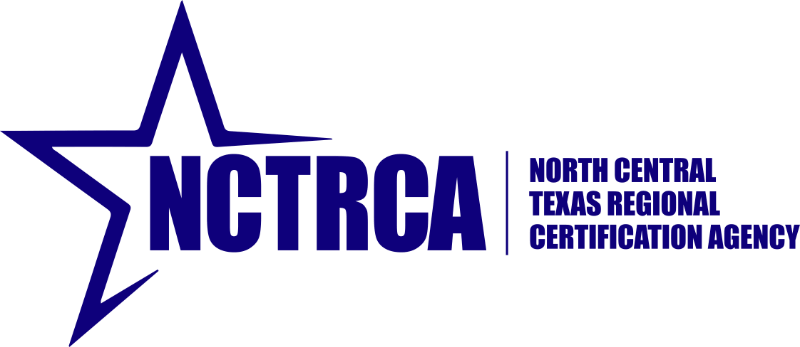Here’s a troubling statistic: The average executive spends only 23% of their time on activities they were actually hired to do. The other 77%? That’s the expensive mystery we’re about to solve.
Think about what you were brought in to do. Drive strategy. Build high-performing teams. Make critical decisions that shape organizational direction. Identify new opportunities. Remove obstacles that block progress. Yet if you tracked your actual time over the past week, how much went toward these high-value activities versus the endless stream of meetings, emails, and “quick questions” that somehow consume entire days?
This disconnect isn’t just frustrating—it’s expensive. When someone at your level operates at partial productivity, the ripple effects cascade through entire departments. Delayed decisions bottleneck teams. Strategic initiatives stall. Innovation slows. The organization pays not just your salary for suboptimal performance but also the opportunity cost of what could have been achieved.
What I’ve learned after coaching hundreds of executives is that this isn’t a personal failure—it’s a systems failure. The leaders who succeed aren’t the ones who work harder; they’re the ones who know exactly where their time goes and ruthlessly optimize accordingly.
The Hidden Cost of Not Knowing
Most leaders operate on gut feeling about their productivity. You feel busy, therefore you must be productive. You’re exhausted by day’s end, so surely you accomplished something meaningful. But feelings lie. Research from Harvard Business School found that executives consistently overestimate their strategic work time by 60% and underestimate administrative tasks by nearly half.
This productivity blindness creates a compound problem. Without accurate data about where time actually goes, every attempt at improvement becomes guesswork. You might invest in new productivity tools that don’t address your real bottlenecks. You might delegate tasks that aren’t actually consuming significant time while keeping the real time thieves. You might restructure your day in ways that actually reduce rather than enhance performance.
“The gap between how leaders think they spend time and how they actually spend it is often shocking, sometimes depressing, but always illuminating.”
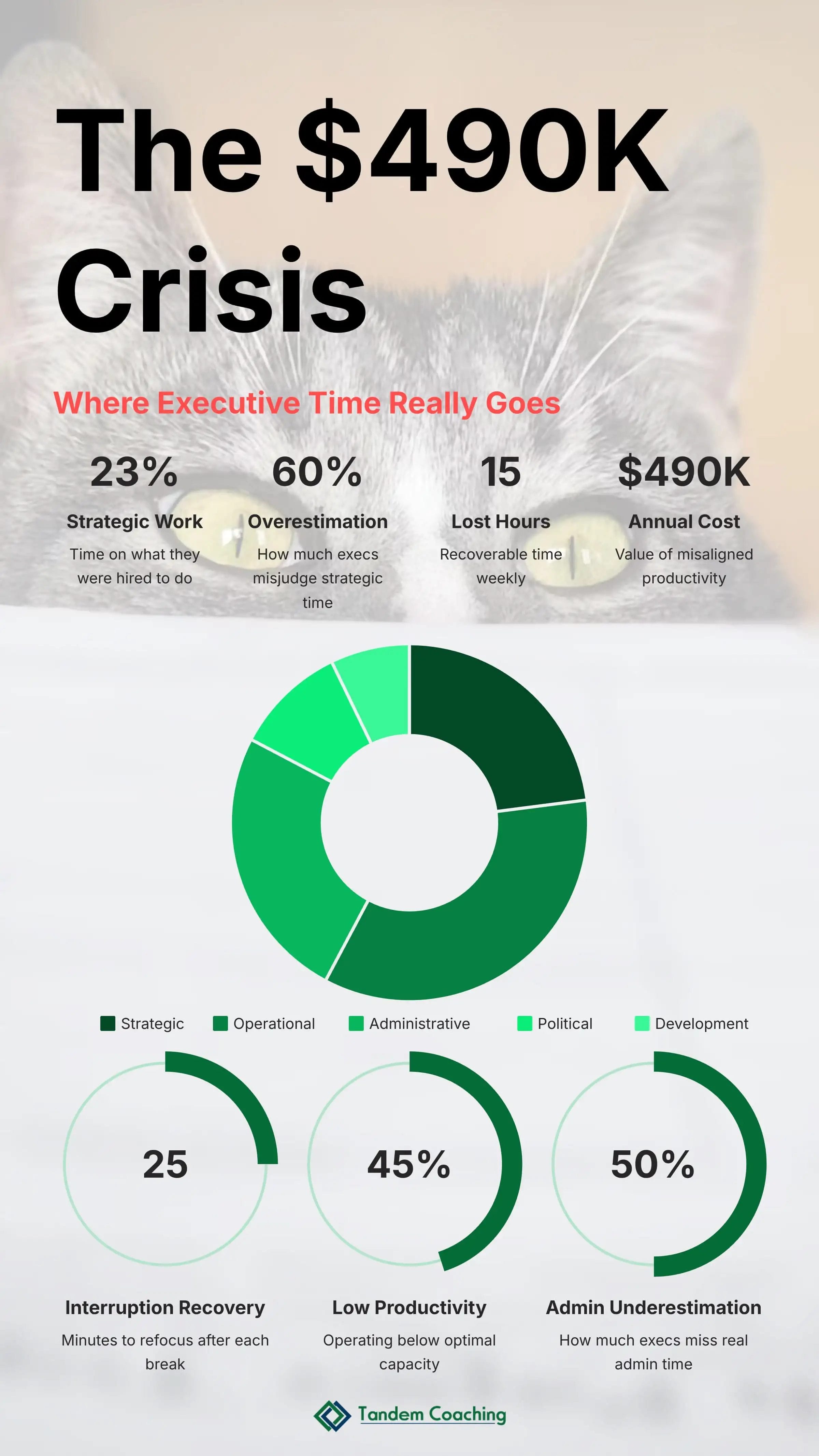
Consider the financial reality. If your total compensation is $300,000 annually, your hourly value to the organization is roughly $150. But that assumes equal value across all hours, which we know isn’t true. Your strategic thinking time might be worth $500 per hour to the organization, while time spent in redundant status meetings might generate negative value by preventing others from moving forward. According to McKinsey’s research on executive time use, misallocated leadership time costs organizations an average of $490,000 annually per senior leader. Understanding these variations is the first step toward optimization.
The productivity audit we’re about to undertake isn’t about judgment or comparison. It’s about creating a factual baseline—a clear picture of current reality from which meaningful change becomes possible. Time and again, I see executives discover patterns they never suspected but that, once revealed, explain years of frustration.
Why Traditional Time Tracking Fails at Leadership Levels
You’ve probably tried time tracking before. Maybe you downloaded an app, committed to logging your activities, and abandoned it within three days. There’s a reason traditional time tracking fails for leaders: it was designed for individual contributors tracking billable hours, not executives juggling strategic complexity.
Traditional time tracking assumes discrete tasks with clear beginnings and endings. Clock in on Project A, clock out, clock in on Project B. But your reality involves simultaneous mental juggling—thinking about quarterly strategy while reviewing a budget while being interrupted by an urgent customer escalation. How do you track the ten minutes you spent mentally solving a problem during your commute? What category captures the dinner where you built crucial relationship capital with a key stakeholder?
Here’s a pattern I can’t ignore: executives who try consumer-grade time tracking tools have a 91% abandonment rate within one week. The tools aren’t wrong; they’re just solving the wrong problem. You don’t need to know you spent 47 minutes in email. You need to know that those 47 minutes of email prevented two hours of strategic thinking because of cognitive residue.
The executive productivity audit takes a fundamentally different approach. Instead of pretending your work fits into neat buckets, we’ll track across multiple dimensions that actually matter at leadership levels. We’ll capture not just time but energy, not just activity but impact, not just what you did but what you prevented or enabled others to do. This multi-dimensional view, validated by research from Stanford’s Graduate School of Business, provides the complete picture traditional tracking misses.
The Executive Time Audit Protocol
The seven-day executive audit captures your complete productivity picture across four critical dimensions. Unlike employee time sheets or consultant billable hours, this framework acknowledges the complex reality of leadership work where strategic thinking happens in the shower and crucial decisions get made in hallway conversations.
Let me share a transformation that illustrates the power of this approach. Sarah, a VP of Operations at a healthcare company, discovered through her audit that she was spending 31 hours per week in meetings—meetings where she rarely made decisions only she could make. Her peak creative hours from 7-9 AM were consumed by status updates that her directors could handle. By restructuring based on audit insights, she recovered 12 hours weekly for strategic work. Six months later, her division’s efficiency metrics improved by 34%, directly attributed to strategic initiatives she finally had time to implement.
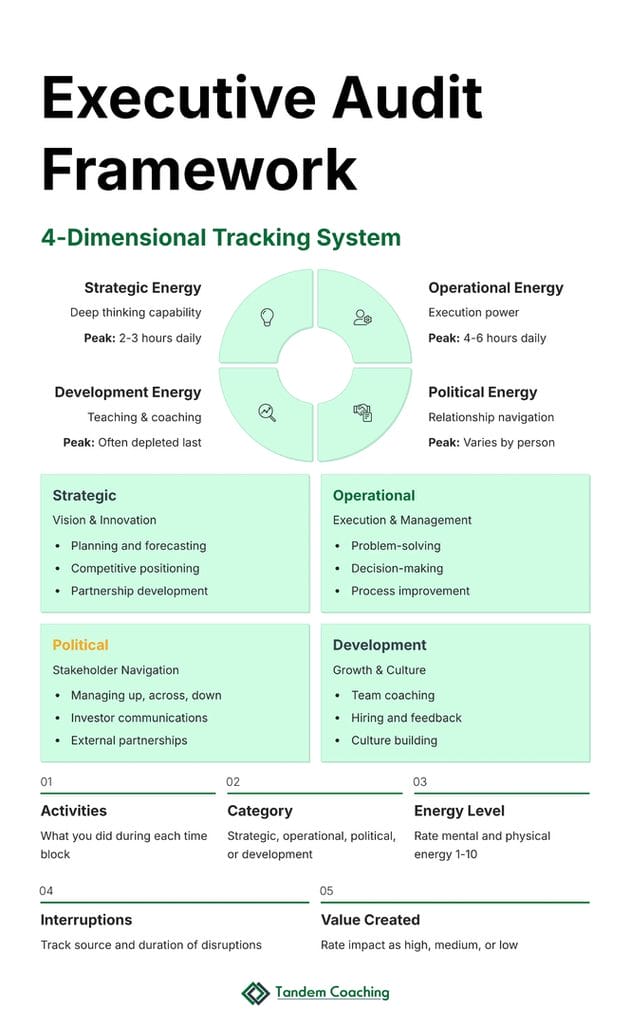
Start your audit on a typical Monday, not during vacation or an unusual week like quarterly planning or annual reviews. You want to capture your normal operating rhythm. Use whatever capture method feels most natural—phone notes, paper notebook, or a simple spreadsheet. The tool matters less than consistency.
Every two hours during your working day, pause for 30 seconds to record: What did I just do? What type of thinking did it require? How much energy did it consume? Who was involved? This periodic snapshot approach proves more accurate than trying to reconstruct an entire day at once.
Track across these executive-relevant categories: Strategic Work (vision, planning, innovation), Operational Management (execution, problem-solving, reviews), Stakeholder Engagement (internal and external relationships), Team Development (coaching, feedback, culture building), Administrative Tasks (emails, scheduling, reports), and Crisis Management (unplanned urgent issues). Note that some activities span multiple categories—a budget review might be both operational and strategic. Your complete tracking system should reflect this complexity.
But time categories alone miss crucial context. A morning strategy session when you’re mentally fresh differs vastly from an evening strategy session when you’re depleted. That’s why the audit includes energy tracking—a dimension most productivity systems ignore but that fundamentally determines your effectiveness.
Mapping Your Four Energy Quadrants
Leadership work demands different types of energy, and understanding your patterns across these dimensions transforms how you structure your days. The four quadrants aren’t about good or bad—each serves essential purposes. The key is alignment between energy availability and work requirements.
Strategic Energy powers vision creation, long-term planning, and innovation. This is your highest-value thinking, requiring mental clarity and freedom from distraction. Most leaders find they have two to three hours of true strategic energy daily, often in the morning but not always. Track when you naturally think about the future versus managing the present.
Operational Energy drives execution, problem-solving, and decision-making. This is your “getting things done” fuel, typically more abundant than strategic energy but still finite. You might have four to six hours of solid operational energy daily, though it depletes faster when switching between unrelated problems.
Political Energy (and yes, we need to acknowledge this reality) enables stakeholder management, influence building, and organizational navigation. This includes managing up, across, and down—the relationship work that makes everything else possible. Some leaders find this energizing; others find it draining. Track honestly. The political capital cost of being unavailable or disengaged during key relationship moments can derail months of strategic work.
“Every hour of misaligned energy—doing strategic work when depleted or administrative tasks during peak performance—costs your organization thousands in lost value creation.”
Development Energy focuses on growing others and yourself. This includes coaching team members, providing feedback, learning new skills, and building culture. It requires patience, empathy, and genuine attention—difficult to fake when depleted. Many leaders discover they’re trying to develop others during their lowest energy periods, explaining why these efforts often fail.
Aligning your energy patterns with your work requirements often produces immediate productivity gains without adding a single hour to your day. The research is clear: energy-task alignment can improve performance by up to 45% according to performance psychology studies.
Discovering Your Peak Performance Windows
Within your audit data hides a pattern worth hundreds of thousands of dollars annually: your peak performance windows. These are the periods when your strategic thinking is sharpest, your decisions most sound, and your leadership most effective. Yet most leaders waste these golden hours on low-value activities.
I invite you to think about your last truly brilliant insight or decision. When did it occur? Likely not during back-to-back meetings or while clearing your inbox. Research from circadian biology shows that cognitive performance can vary by up to 50% throughout the day, yet we treat all hours as equal.
The audit will reveal when you naturally enter what researchers call “flow state”—periods of intense focus where complex problems suddenly seem simple. For some, it’s the quiet morning hours before the organization wakes up. For others, it’s late afternoon when the meeting marathon ends. Some discover surprising patterns, like peak creativity during their commute or maximum strategic clarity during evening walks.
Pay particular attention to what happens immediately before and after these peak windows. Often, leaders unconsciously protect these times but then immediately squander them. You might arrive early to think strategically, then spend that precious time clearing overnight emails. You might stay late for focused work, then get pulled into “quick questions” from team members also working late.
The financial impact of optimizing these windows is substantial. If you have three peak hours daily and currently waste two of them on low-value work, recovering even half of that time for strategic activities could transform your organizational impact. That’s 250 hours annually of your highest-value thinking—equivalent to adding six weeks of peak performance without working longer hours. Download our Peak Performance Calculator to quantify your potential gains.
The True Cost of Interruptions
Your audit will expose an uncomfortable truth: interruption is likely your single largest productivity destroyer. But the real cost goes far beyond the interruption itself. Research from UC Irvine shows it takes an average of 23 minutes to fully refocus after an interruption. For complex strategic thinking, that recovery time can stretch to 45 minutes.
Here’s what executives never expect: the “quick question” phenomenon. Track your interruptions across three dimensions: source (who or what interrupted), duration (how long the interruption lasted), and impact (how long before you returned to previous effectiveness). Most leaders discover shocking patterns. The “quick question” from a team member averages 15 minutes but costs 40 minutes of productivity. The “urgent” email that could have waited until tomorrow fragments an entire afternoon of strategic planning.
Calculate your interruption tax using this formula: Number of interruptions daily × average recovery time × your hourly value. For most executives, this number exceeds $2,000 daily in lost productivity. Multiply by 250 working days, and you’re looking at half a million dollars in annual interruption cost—and that’s just for you, not counting the cascade effect on your team.
But not all interruptions are created equal. Your audit should distinguish between truly urgent issues requiring immediate attention and what I call “convenience interruptions”—people interrupting you because it’s convenient for them, not because it’s necessary. The ratio typically runs 1:4—for every genuine emergency, you’ll face four convenience interruptions that could have waited.
“The most expensive interruptions aren’t from others—they’re self-inflicted. That reflexive email check costs more than any meeting.”
The most expensive interruptions are indeed self-inflicted. That reflexive email check during strategic planning. The “quick peek” at messages during a coaching conversation. The inability to resist joining a discussion you hear happening outside your office. These voluntary interruptions often outnumber external ones by 2:1, yet they’re entirely within your control to eliminate. Managing these context switches becomes crucial for sustainable productivity.
Analyzing Your Meeting ROI
Meetings represent the largest single time investment for most leaders—and often the worst return. Your audit will likely confirm what you suspect: you’re spending 20-25 hours weekly in meetings, yet fewer than half genuinely require your presence or input. The rest represent organizational theater, political obligation, or simple habit.
Consider this productivity theater: the weekly status meeting where everyone performs the ritual of updating each other on work that could be communicated asynchronously. The “alignment session” where no actual alignment occurs. The “brainstorming meeting” with no clear problem to solve. These performances consume thousands of hours annually while creating an illusion of productivity.
Track each meeting across five criteria: Was my unique perspective essential? Did I make decisions only I could make? Did my presence enable others to move forward? Could this have been an email or document? What was the opportunity cost of attending? This ruthless assessment often reveals that 40-60% of meeting time creates no real value.
Calculate the true cost of each recurring meeting. Include not just your time but preparation, travel (even walking between offices), recovery time, and the work that doesn’t happen while you’re meeting. That weekly status meeting might cost $50,000 annually when you factor in all participants’ time. According to Atlassian’s research on meeting effectiveness, unnecessary meetings cost U.S. businesses $37 billion annually.
The audit also reveals meeting patterns that destroy productivity. The Swiss cheese schedule—meetings scattered throughout the day with unusable gaps between them. The meeting marathon—back-to-back sessions that leave no time for processing or action. The timezone torture—global teams requiring meetings at cognitive low points. Each pattern has solutions, but first you need to see the pattern clearly.
Transforming your meeting culture often starts with you modeling different behavior. When leaders start declining unnecessary meetings, leaving meetings that don’t need them, and insisting on agendas and outcomes, organizational meeting culture shifts remarkably quickly.
Building Your Productivity Baseline Score
After seven days of tracking, you’ll have roughly 100 data points across multiple dimensions—enough to establish your productivity baseline. This isn’t about judgment or comparison to others; it’s about creating a factual starting point for improvement.
What I’ve noticed working with executives across industries: those who measure their baseline invariably find at least 10 hours of recoverable time weekly. Not through working harder or longer, but through simple reallocation based on data rather than assumptions.
Calculate your Strategic Work Percentage: Hours spent on activities only you can do ÷ total working hours. If this number is below 30%, you’re operating as an expensive individual contributor rather than a leader. Below 20% indicates crisis mode—you’re so trapped in operational work that strategic thinking has essentially stopped.
Determine your Energy-Task Alignment Score: How often does your high-value work align with high-energy periods? Score each day from 1-10, then average across the week. Most leaders score 4-6, indicating massive room for improvement simply through better scheduling. Access our Energy Alignment Worksheet to map your patterns.
Assess your Interruption Recovery Rate: Total time lost to interruption recovery ÷ total working time. Anything above 20% indicates that interruption management should be your first optimization priority. Above 30% means interruptions have essentially taken over your day.
Measure your Meeting Value Ratio: Meetings where you added unique value ÷ total meetings attended. A ratio below 50% suggests aggressive meeting reduction is needed. Below 30% indicates you’re attending meetings primarily for political reasons rather than value creation.
“Your productivity baseline isn’t a judgment—it’s a GPS coordinate showing exactly where you are so you can navigate to where you want to be.”
These four scores combine to create your Executive Productivity Index—a single number representing your current operational effectiveness. Most leaders initially score between 45-65%. Getting to 75% or above typically requires systematic changes rather than incremental improvements.
Turning Audit Insights into Action
The patterns your audit reveals will likely trigger both recognition and resistance. Recognition because deep down, you knew something was broken. Resistance because changing these patterns requires confronting organizational expectations, personal habits, and often your own identity as someone who’s “always available” or “hands-on with everything.”
Let me be clear about this: the audit data doesn’t lie, but it also doesn’t dictate. You might discover that those “unproductive” coffee conversations prevent larger fires. Perhaps that thinking time during your commute is actually your most creative period. The goal isn’t to maximize every minute—it’s to optimize the minutes that matter most.
Start with the highest-leverage changes—those requiring minimal effort but yielding significant results. If your audit shows peak strategic thinking from 7-9 AM but you’re currently using that time for email, simply shifting email to afternoon could transform your effectiveness. If Tuesday mornings are interruption-free but filled with low-value tasks, redesignating this as strategic planning time costs nothing but delivers massive returns.
Next, address the structural issues. If meetings consume more than 40% of your time, you need meeting protocols, not just schedule adjustments. If interruptions fragment every day, you need boundaries and communication systems, not just a closed door. If energy misalignment is chronic, you need role redesign, not just better time management.
The audit also reveals what not to change. Perhaps those informal coffee conversations you considered “waste” actually prevent larger problems. Maybe that thinking time during your commute is your most creative period. Productivity improvement isn’t about maximizing every minute—it’s about optimizing the minutes that matter most.
Remember that your productivity doesn’t exist in isolation. Every change you make ripples through your team and organization. Communicating these changes effectively helps others support your new patterns rather than unconsciously sabotaging them. In fact, transparent productivity improvement often inspires team-wide optimization.
Your Next Seven Days
The productivity audit is just the beginning—a diagnostic tool that reveals where you are, not where you could be. But this baseline data becomes the foundation for systematic improvement. Without it, you’re guessing. With it, you’re engineering.
Over the next seven days, I invite you to commit to the audit protocol. Five minutes every two hours. Track time, energy, interruptions, and meetings. Be honest about what you discover. Some patterns will surprise you. Others will confirm what you’ve long suspected but haven’t wanted to acknowledge.
Most importantly, suspend judgment during the audit week. Don’t try to change behaviors while measuring them—you’ll skew the data and miss important patterns. There will be plenty of time for optimization once you understand your current reality.
Consider downloading our Executive Productivity Audit Template which includes:
7-day time tracking spreadsheet with executive-relevant categories
Energy pattern assessment worksheet
Meeting ROI calculator
Interruption impact analyzer
Quick-start audit guide with video walkthrough
After seven days, you’ll have something precious: objective truth about your productivity. Not feelings or assumptions, but facts. From this foundation of truth, meaningful change becomes not just possible but inevitable. Because once you see where your time really goes, you can’t unsee it. And that awareness alone often triggers immediate improvements.
The path from your current productivity to your potential productivity isn’t mysterious—it’s mathematical. Recover two hours daily of high-value time. Align energy with activity. Reduce interruptions by half. Cut unnecessary meetings. These aren’t radical changes, yet they can double your strategic output without adding a single hour to your workday.
Once you have your baseline data, you’re ready for the next step: implementing a comprehensive capture and organization system that ensures nothing falls through the cracks while freeing your mental energy for strategic thinking. The audit shows you what’s broken; GTD for Executives shows you how to fix it systematically.
Frequently Asked Questions
I travel frequently and my schedule varies wildly. When should I do the audit?
Pick a week that represents your most common pattern, even if it includes some travel. The audit should capture your typical reality, not an ideal week. If you travel more than 50% of the time, conduct two separate audits—one for travel weeks and one for office weeks. The patterns often differ dramatically, requiring different optimization strategies.
How do I track work that happens outside normal hours—evening emails, weekend thinking time, middle-of-the-night problem-solving?
Include it all, but mark it clearly as outside standard hours. This often reveals the true scope of your work commitment and highlights unsustainable patterns. Many leaders discover they’re essentially working two jobs—their official role plus an invisible second shift of catch-up work.
What if my organization's culture makes it impossible to change these patterns?
The audit reveals what is, not what must be. Start by understanding your patterns, then identify which changes lie within your control versus those requiring organizational shift. Often, leaders have more autonomy than they realize but have never tested the boundaries. Even in rigid cultures, small changes can yield significant results.
Should I tell my team I'm doing this audit?
Yes, but frame it as personal productivity improvement rather than judgment on organizational practices. This transparency often inspires others to examine their own patterns and can catalyze team-wide productivity improvements. It also helps explain any temporary changes in your availability during the audit week.
How often should I repeat the audit?
Conduct a full seven-day audit initially, then quarterly check-ins using just two or three days of tracking. Major role changes, team restructuring, or significant strategic shifts warrant complete re-auditing. Think of it like financial audits—periodic verification that your time investments align with your intended returns.
What if the audit reveals I'm in the wrong role entirely?
This happens more often than you’d expect. Sometimes the audit reveals fundamental misalignment between your strengths and your role’s requirements. This information is valuable, whether it leads to role redesign, delegation changes, or career decisions. Better to know than to spend years wondering why work feels so difficult.
Can AI tools do this tracking automatically?
Several AI tools claim to track productivity automatically, but they miss crucial context that only you can provide. They can’t distinguish between a strategic conversation disguised as a casual chat and genuine time-wasting. They can’t assess your energy levels or recognize when apparent “downtime” is actually your most creative thinking. Use technology to support the audit, but don’t outsource the analysis entirely.
Your Productivity Transformation Starts Now
The seven-day productivity audit isn’t just another time management exercise. It’s a mirror that reflects the truth about how you’re investing your most valuable resource. That truth might be uncomfortable, but it’s also liberating. Because once you know where you are, you can chart a path to where you want to be.
If you’re ready to go beyond basic tracking to systematic productivity transformation, I invite you to explore our Executive Productivity Fundamentals program. Through personalized assessment, customized system design, and ongoing optimization support, we help leaders build productivity systems that actually work at executive scale. Discover why executives who complete our program consistently recover 10+ hours weekly while improving their strategic impact.
The choice is yours: continue operating on assumptions about your productivity, or invest seven days in discovering the truth. Your organization is counting on you to operate at peak effectiveness. Your team needs you focused on work only you can do. Your own satisfaction depends on aligning your time with your true priorities.
Start your audit tomorrow morning. In seven days, you’ll have the data you need to transform your productivity. In 30 days, you’ll be operating at a fundamentally different level. In 90 days, the compound effect of these improvements will be evident throughout your organization.
The path forward is clear. The only question is: When will you take the first step?











